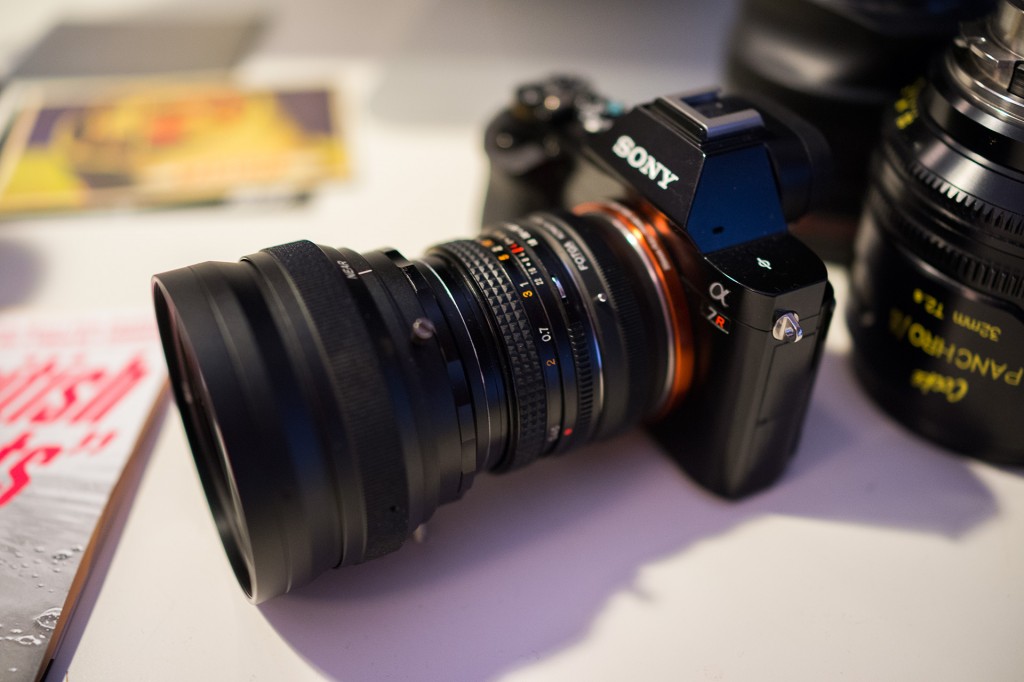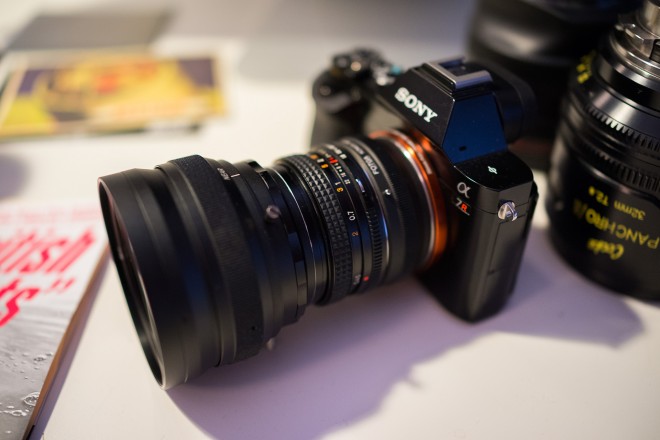
Above: A7R with the new SLR Magic “Anamorphot 50” anamorphic lens
Micro Four Thirds vs full frame. America has answered this question pretty resoundingly – mirrorless sales are apparently down 47%. I don’t think this will be a lasting trend because mirrorless is moving forwards in terms of image quality and features far faster than DSLRs are.
The Sony A7R is the highest spec of all of them, at least in terms of the sensor and EVF. But does it have what it takes for Sony to erode the dominance of Canon and Nikon?
On the face of it this review should be easy because I love full frame and I love mirrorless.
Unfortunately Sony have created a great camera with two significant flaws. These might not be a deal breaker for everyone but for me they’re quite serious.
The first big flaw is unfortunately video related. The image is just not good enough. The A7R has very similar video quality to the Nikon D800 as it shares such a similar sensor. What have Sony done with the A7R to improve video? Very little! Sadly the codec (AVCHD) and encoder are worse than on the Nikon D800. The image has a tendency to break-up. With the weak codec, when things move around a lot you’ll notice a lot of mud instead of smooth motion blur, especially in 1080/60p mode. The latter mode is only really of use to filmmakers when it comes to slow mo but for this there’s a large range of more affordable alternatives that do 1080/60p such as the Nikon D5300 and Panasonic GH3 with much stronger codecs.
Why can’t the video mode on the A7R give us similar results to the camera’s own JPEG engine at just 2MP resolution?
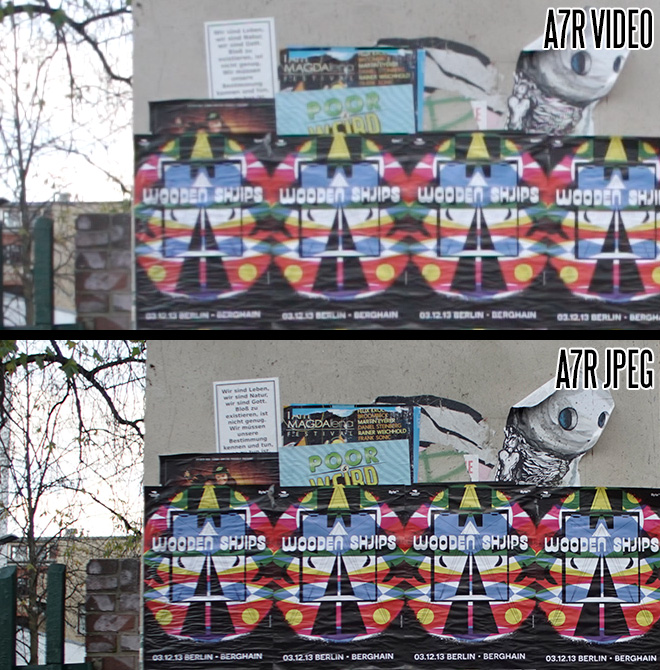
The same picture profile was used for both of these shots.
Colour, clarity and dynamic range isn’t the only casualty of the A7R’s poor video mode.
The fine patterns you see everywhere in daily life cause an eye watering moire patterns on the A7R, whereas rival cameras like the Canon 5D Mark III and Nikon D5300 have no such issues.
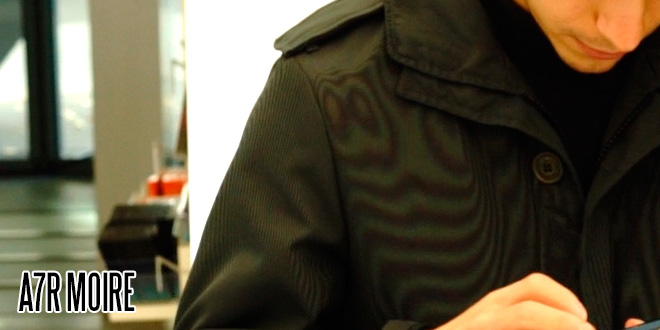
Considering the clear focus on video in the cameras Sony’s own sensors ended up in, I find it very strange that more attention wasn’t given to video quality on either the A7’s 24MP sensor or the A7R’s 36MP sensor.
A similar Sony 24MP sensor we have seen before on a dedicated video camera, not just the A99 and RX1. This camera was the NEX-VG900 which comes in at the bottom of the pile for video quality – around a similar level to Sony’s own bottom of the range NEX cameras like the $400 3N. The VG900 was a $3000 camera!
Video quality hasn’t moved on much from the 3 year old Sony NEX 7 and NEX 5N. All of them fall quite some way short of the ageing Sony FS100 which has a much cleaner image and better AVCHD implementation. Add a $400 Metabones Speed Booster and you gain 1 stop of light and the full frame image circle of your lens on NEX cameras (almost – it’s a 1.1x crop). Consider the NEX 7 – it is now just $500 used so quite a bargain. A used FS100 now goes for close to the price of an A7R body. Sony won’t therefore be winning many new fans on the basis of what the A7R provides filmmakers.
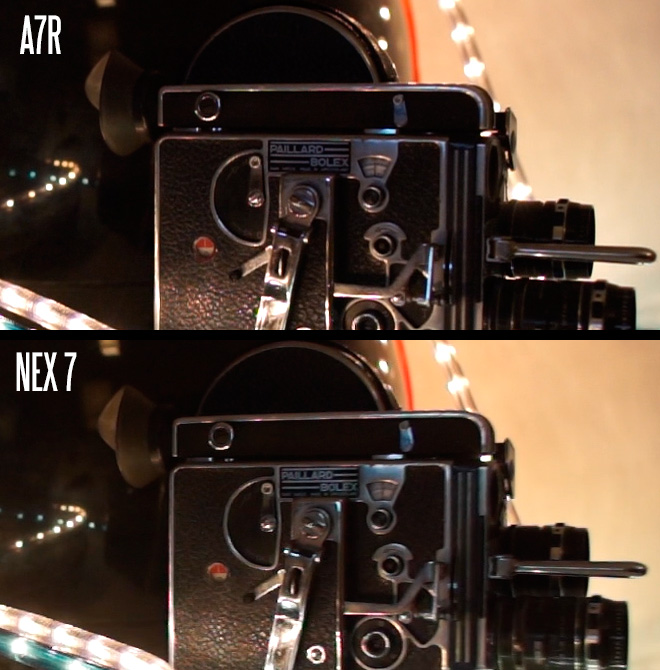
For the above shot the NEX 7 was fitted with the same lens as the A7R, but on the Speed Booster for a 1.1x crop over the A7R instead of the 1.5x for APS-C.
As you can see the difference is pretty minimal but should be more considering the price gap and age difference of the camera, not to mention the positioning in the Sony range, with the A7R ranking at the very top of the consumer / prosumer range.
[vimeo]http://vimeo.com/80134787[/vimeo]Competition hotting up
Despite being the only consumer priced full frame mirrorless camera, the A7R has a lot of competition. Video on Micro Four Thirds had always had an advantage over DSLRs in that the mirrorless systems are designed around a video feed, in other words “live view”, so the engineers have placed more emphasis in the core design on video, whether the user uses this video stream to compose a still shot or record video, the camera is basically a video camera. No mirror box and no optical viewfinder!
So where does the Sony A7R fit into the video landscape?
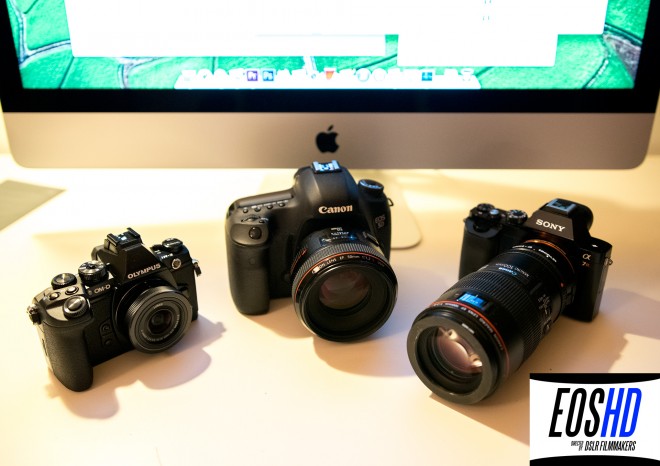
In terms of overall design and concept, the lovely full frame sensor and big OLED EVF are as appealing for video users as they are for photographers. It’s just a big shame about that mediocre video quality compared to other cameras. Don’t get it for the video quality alone. Make sure the other features give you a reason for buying…
Lenses and stills
EOSHD is a video site and I’m a filmmaker but I don’t know any filmmaker or cinematographer who doesn’t also love taking stills, and wants a great stills camera.
The biggest feature for me of this camera is definitely the stills side overall. There’s nothing else like it.
It isn’t a perfect camera for photography but it’s pretty close!
Yes there are a few ergonomic design flaws and the very loud mechanical shutter lets it down as a street-shooter.
But these aren’t big problems. The camera is great. The Sony lenses are tack sharp, the 55mm extraordinarily so. But why are there so few of them and why are there no affordable ones?
To have fast AF on the A7R you need to invest in a completely new range of Sony FE lenses and they are pricey. Although the Sony 55mm F1.8 is a bargain at $999 when you consider it performs similarly to the $4000 Zeiss Otus, Sony only have one such option for a fast 50mm prime – the high end one – and no other! Fast 50’s for Canon and Nikon systems start at around $150. Where is the lower end Sony 50mm prime? The answer is that it’s sitting in the NEX APS-C range, for around $299 and with OSS. You can only use it in APS-C mode on the A7R so not much use compared to a Canon 50mm F1.4 or 1.8 is it?
The 35mm F2.8 FE is again a superb performer but both primes lack OSS, so there’s no stabilisation at all in video mode. On the Sony RX1 stabilisation is provided electronically and on the A99 it’s in-body sensor shift – but neither Sony technology is present in the A7R. Only the two Sony zoom lenses are stabilised, but they have a slow aperture making them unattractive for a lot of video work indoors or in low light.
Manual focus primes from other manufacturers are therefore the way to go…
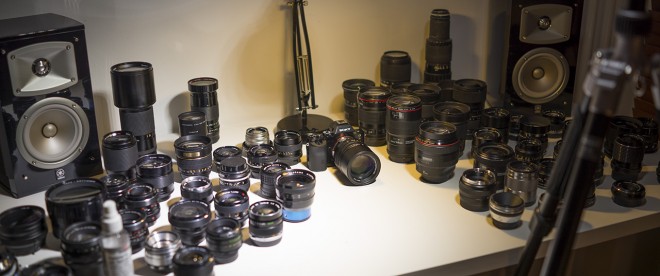
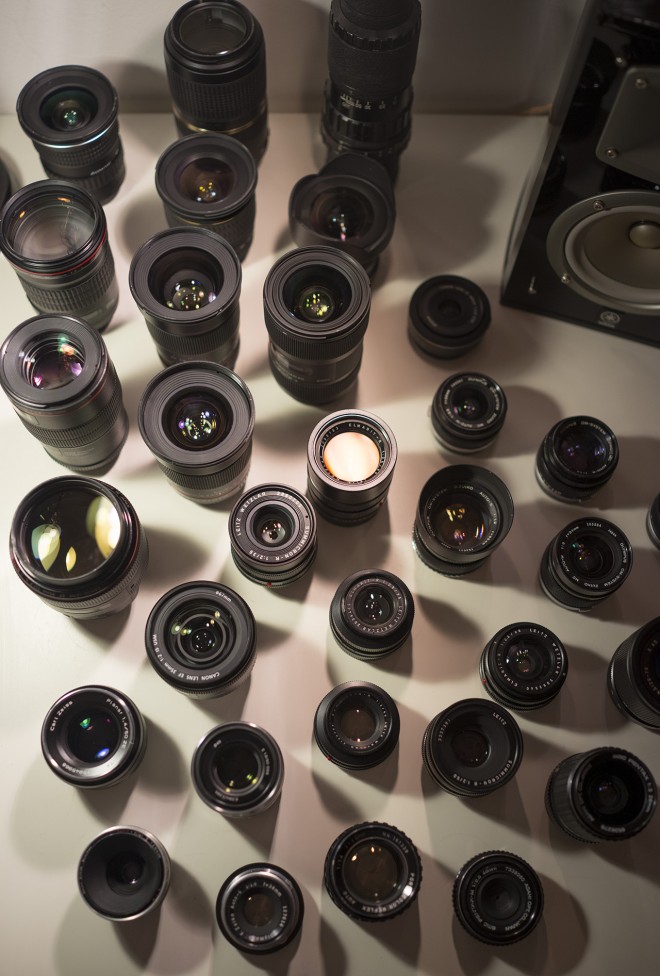
This is where the A7R comes in extremely handy is for manual focus and using half a century worth of beautiful lenses on the sensor format they’re designed for.
The A7R is a legacy lens user’s dream and this route can be extremely affordable (depending on how addicted you get).
I’m currently writing a book about the subject because it’s so broad. I can use over 100 of my full frame lenses on the A7R, some for the first time on full frame like the Canon FD series and Leica M mount SLR Magic 50mm T0.95 which gives the Leica Noctilux a run for its money.
Check out some of Richard Gale’s absolutely incredible custom lenses fitted to the A7R and Blackmagic Pocket Cinema Camera –
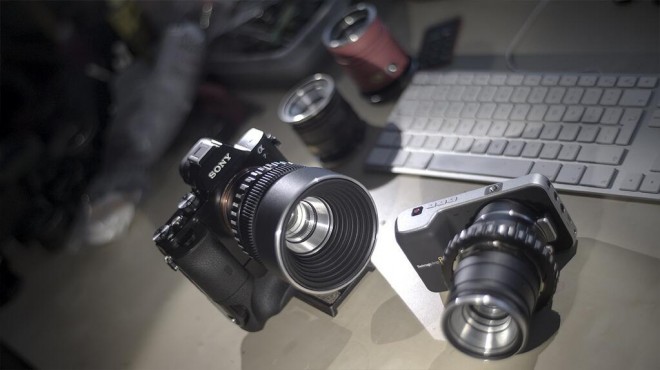
Leica M glass
For Leica M owners the A7R is again very interesting because LM mount lenses are compact, full frame and high quality, maintaining the image quality and small size advantage of the A7R for stills over Canon DSLRs.
Putting a cheap lens adapter on the A7R which sticks out quite far from the body does let the swanky finish down a bit. A Leica M to E mount adapter is so small as to be pretty much ignorable.
Sadly Leica glass is the preserve of the elites.
And I don’t think that the Leica glass really compensates for the drop in video quality from the 5D Mark III. If it’s high end glass we’re talking about I prefer the look of a Canon 50mm F1.2L on the 5D Mark III in raw video mode with Magic Lantern to the A7R.
Though the SLR Magic 50mm T0.95 is extremely tasty on it…
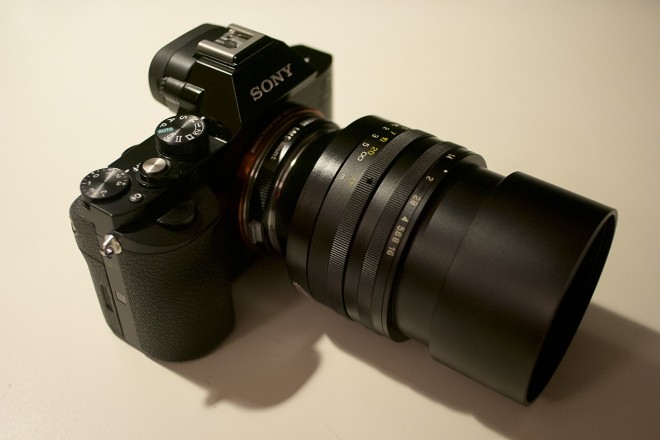
Brand wars
Something which has come up recently a lot is “why hasn’t mirrorless truly taken off outside Asia?” Simple answer – brand appeal. Japanese companies have a home advantage. Panasonic are very well respected in Japan, anything they do in any market is trusted by the Japanese consumers. In the West, consumer electronics giants have had their work cut out to prove that they can be trusted when it comes to non-core businesses like camera equipment. Sadly the Lumix brand just doesn’t have the appeal of Canon EOS or Nikon yet.
The situation with Sony is slightly different, because Sony are one of THE most illustrious brands in the West, thanks to their iconic non-camera products, the Walkman, Playstation, smart-phones and TVs. The NEX 7 was a serious mirrorless camera and Sony’s NEX brand had gained so much recognition with customers that it had eclipsed the actual Alpha camera brand. Sony’s solution was to kill the stronger brand so NEX is no more. This I think was a huge mistake. NEX should have been kept for the APS-C and mid-range NEX cameras. The successor to the NEX 5 for example is dubbed A5000 which customers consider almost meaningless. The A7R is a chance to bolster the Alpha brand at the high end and it does so well, but don’t be surprised when Sony bring the NEX brand back to the rest of the range.
A personal preference for the Olympus E-M1?
The E-M1 gives me the biggest pause for thought on the A7R. Ideally I’d only keep just one camera and spend my money on glass.
For video the E-M1 is genuinely unique because of the stabilisation with ALL lenses, legacy or new. Not only that but stabilisation is a particularly weak point on the A7R. So big big win for Olympus on that one. For stills or video, composing a shot through the equally big EVF on the E-M1 is far more comfortable than on the A7R because the stabiliser allows you to focus manually without blur and jitter making the job much harder.
I find I get less eye-strain with the E-M1’s EVF and though contrast and resolution have a slight edge on the A7R’s state-of-the-art OLED panel, the E-M1’s panel is a huge step up from the E-M5. The LCD too, is equally as good as the one on the A7R.
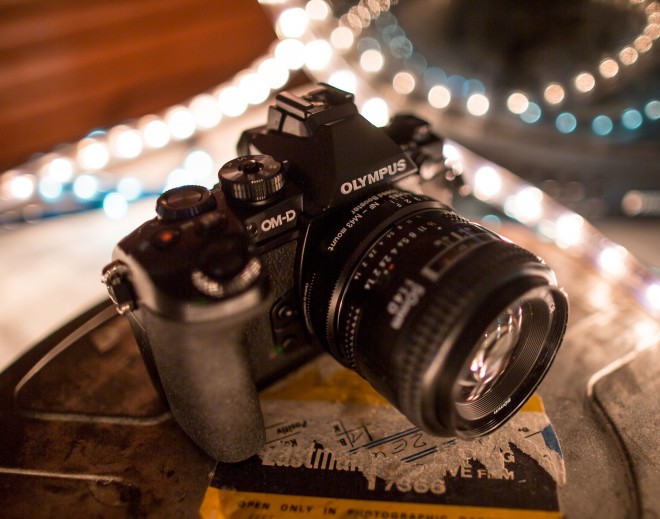
Yet common criticisms levelled at Micro Four Thirds cameras continue to get repeated – they’re slow, have long blank outs during burst mode shots, the sensors are too small, build quality – toy-like, viewfinder – not as good as an optical one. With the high end models this is simply no longer true. Of course it doesn’t help that a huge influx of lower end models like the GF series and PENs have flooded shelf space which should have been reserved for premium models. There’s not enough retail outlets in the US with shelf space devoted to high end Micro Four Thirds cameras. As a result the brand isn’t considered “premium” by enough buyers.
The E-M1 is the faster camera compared to the A7R, it feels more responsive. It does stills at 10fps with a machine gun like shutter and live 10fps shot preview with no blankout of the viewfinder. AF is as fast as a DSLR and the sensor has phase detect AF strips on it. Small sensor? With the Metabones Speed Boosters it’s a 1.4x crop sensor, larger than APS-C and just shy of APS-H and full frame. The E-M1 has a magnesium alloy chassis and is cold to the touch. Just like a top of the range Canon or Nikon DSLR.
The A7R doesn’t feel as responsive to use and the body doesn’t feel as solid as the E-M1’s despite being of similar build quality.
Those looking for a good zoom lens and more camcorder-like run & gun camera, don’t forget to consider Sony’s own RX10 which shoots video with more detail and less moire & aliasing (though some is still present) than the A7R –
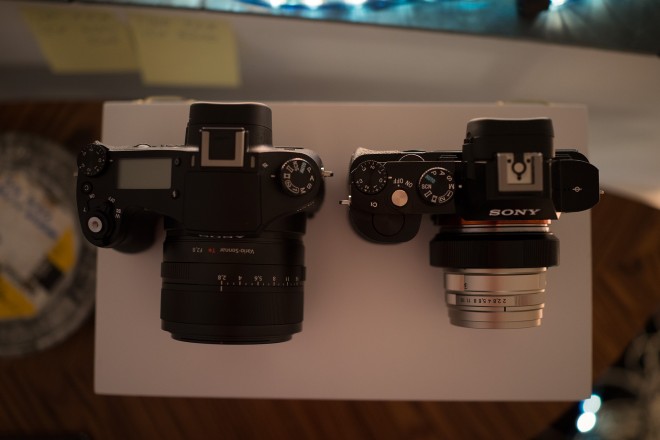
APS-C vs full frame
Canon and Sony seem keen on maintaining the gap between APS-C and full frame. A replacement for the NEX 7 or Canon 7D is long overdue and Sony’s A5000 is in my view a poor imitation of the NEX 5N, with a lot of video features removed such as the mic socket and manual audio controls.
Olympus and Panasonic on the other hand seem keen to close the gap to full frame, and that strategy is paying off on paper.
What about you? What strategy is working? Will you buy a 7D Mark II when the 6D is around for a similar price? Will you invest in E-mount lenses for the A7R or stick with the smaller sensor in Micro Four Thirds cameras?
[polldaddy poll=7725420]
Uncompressed HDMI output – what’s the point if it isn’t 10bit 422?
HDMI on DSLRs to date has been touted as uncompressed and 4-2-2 by the manufacturers. The lack of compression isn’t the main thing though, because the damage to the image is done as soon as it’s sparsely sampled on the sensor. I don’t see any evidence of it being 4-2-2 either. You can store it in a 4-2-2 format on your external recorder but the sensor most likely still samples colour at 4-2-0 in video mode which leads to pixelation especially around bright red highlights. To date only the Blackmagic Pocket Cinema Camera has been able to deliver a true 4-2-2 (in 10bit no-less) pipeline from sensor to HDMI port.
So the HDMI port on the A7R just bypasses the AVCHD encoder – the debayer and sensor output remain of low quality. Nevertheless with a Small HD DP6 for monitoring, backed onto a Blackmagic HyperDeck Shuttle – this was my poor man’s Odyssey 7Q on the A7R!
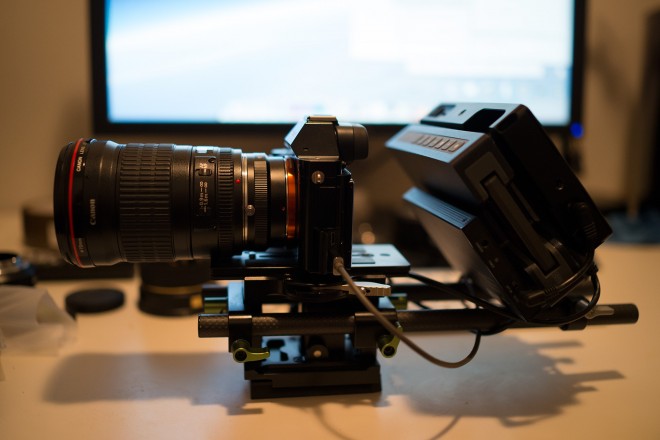
I’ve used velcro to sandwich the screen, recorder and 2.5″ form factor SmallHD battery together and it works rather well if we forget Magic Lantern raw video or Blackmagic ever existed.
The “Deep” Picture Profile (set to -3 +0 -3) seems to gives best colour when used with an external recorder, though you need to crush the shadows and use Film Convert Pro to make it look half decent. HDMI is clean when info. display set to “Off” otherwise the camera will output all the menus and overlays. So be careful to check this if using an external recorder. An annoyance when using an HDMI recorder is that the A7R always starts up in playback mode when an HDMI cable is connected (even when no SD card inserted). Clearly the needs of your mum and her television set got in the way of Sony catering to filmmakers on that one. Next time – just give us the choice in the menus!
Let’s get things into perspective. Where does the A7R’s image rank overall when it comes to the whole filmmaking spectrum for low end to high end?
- Alexa
- Sony F65
- Red Dragon
- Sony F55
- Canon 1D C and C500 (in 4K)
- 5D Mark III (Magic Lantern Raw Video)
- Blackmagic cameras
- Canon C300 / C100 with ext. recorder
- Panasonic GH3 / GM1 / GH2
- 5D Mark III (Stock ALL-I 1080p codec)
- Nikon D5300
- Olympus E-M1
- Canon 5D Mark II /w Mosaic Engineering AA filter
- Nikon D800
- Sony A7R
- Nikon D610
- Sony A7
- Sony NEX 7 / 5N
- Canon Rebels and the new 70D
- Samsung’s stuff
- Fuji’s half-attempt at something video related
Conclusion
If you love full frame for stills and want the most adaptable lens mount to use all your lovely old lenses on, the A7R is the best you can get.
If you just want a lovely cinematic video mode then the A7R is somewhat disappointing. It doesn’t replace any of my cameras for video in terms of either features or quality. We’re not talking expensive stuff here. The A7R is humbled by the $799 Nikon D5300 and $699 Panasonic GM1. Let’s not even mention the Blackmagic Pocket Cinema Camera!
Sony need to improve their codec, give us higher bitrates and colour sampling, get rid of the moire, increase dynamic range, improve colour and generally just get their video output closer to the JPEG output for 2MP stills because at the moment it is a bit too ‘VHS’ for my liking. Fine for home movies but not for enthusiasts, artists or aspiring filmmakers, let alone pros.
With this camera being aimed at enthusiasts and prosumers you’d have thought the video mode would be taken a bit more seriously. Indeed there are lots of features, many of them serious, like uncompressed HDMI output and plenty of manual audio control & inputs – so why then is the image quality distinctly non-serious?
It doesn’t really replace a Micro Four Thirds camera for video, because both the Olympus E-M1 and Panasonic GH3 have a better image and features. Especially in low light, for video, the Nikon D5300 looks better. The GH3 has the lovely codec. The E-M1 has the amazing stabilisation. The D5300 has 1080/60p. The A7R has the biggest sensor but what else? The 5D Mark III is full frame too, it’s hardly unique, but none of the same moire / aliasing problems as the A7R.
In a nutshell
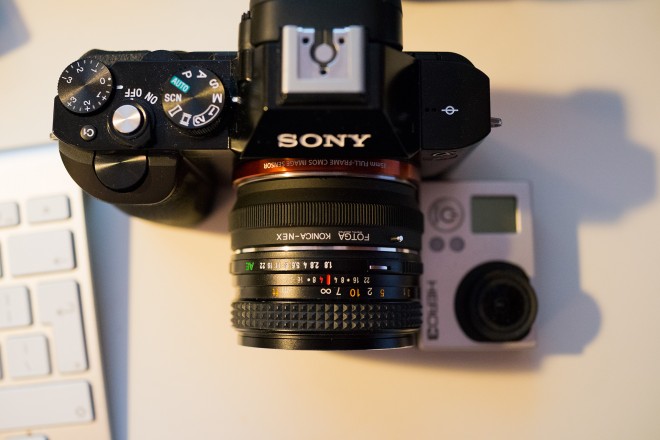
All in all, Sony have done a largely very brave and respectable job on the A7 and A7R as a stills camera. The premium A7R has the edge on video quality over the cheaper A7 but falls well short of the competition, some of it from Sony themselves in the form of the RX10 and much of the other solutions are cheaper too! Panasonic G6, Blackmagic Cinema Camera, Nikon D5300 – all better for video.
Enthusiasts will love the stills but are better served by the 5D Mark III or Panasonic GH3 for video. Stills users should also seriously consider the Olympus E-M1 for the superior ergonomics, native lens range and AF. Yet the A7R is ultra-special in terms of outright stills quality with 36MP resolution and 14 stops dynamic range, combined with the ability to use almost any traditional SLR lens via an adapter.
Overall rating
- 6/10 for video
- 8/10 for stills
Pros
- Full frame
- Mirrorless lens mount
- Class leading sensor technology, incredible image quality (for stills not video)
- Class leading EVF panel matched by the quality of the viewfinder optics (unlike previous E-mount cameras)
- 1080/60p
- Articulated screen
- Good build quality and finish (though slightly plain design lacks the charm of Fuji or Olympus)
- Small size for a full frame camera
- Body reasonably priced (though expensive FE mount lenses)
- Incredible for adapting to wide range of manual focus lenses
- Mic and headphone socket
- Manual audio gain controls
Cons
- Unexciting video quality far surpassed by cheaper competition and Canon 5D Mark III
- Moire and aliasing problems in video mode
- Poor codec with mud on motion blur, especially in 1080/60p mode
- No electronic stabilisation in video mode (RX1 has it), must rely on using FE lenses with OSS, of which only 2 exist at launch!!
- Dated AVCHD video file format offers no advantages compared to Quicktime MOV of Nikon D800, 5D Mark III and GH3 (awkward directory structure for playing back individual clips on a computer, terrible Quicktime Player support on Macs)
- MP4 video file format only 1440 x 1080 at 12Mbit!
- Low light performance in video mode lags competition especially Nikon D5300 and Panasonic GM1
- Poor battery life on a single charge and no dedicated charger unit included in the box
- No sensor shift stabilisation like previous Sony Alphas (A99, A77, etc.)
- Body feels cheaper than other high end full frame DSLRs
- Very loud shutter, seems out of place with rest of camera
- Uncompressed HDMI output a waste of time (only 8bit, Blackmagic Pocket Camera HDMI is 10bit for $999 and 10bit ProRes internally!)
- Awkwardly placed video record button, almost impossible to press whilst holding camera grip
- More cluttered controls than the RX1 (needlessly so)
- FE mount lens range expensive and lacks options (though of high quality)
- Far wider range of AF lenses on other system (especially Canon, Nikon and Micro Four Thirds)
- Body styling and small form factor suffers when DSLR or SLR manual focus lens attached by adapter
- Low quality manual focus assist in video mode compared to stills mode
- Shutter button too easy to half-press by accident, exiting punch-in focus assist
- Video record button cannot be assigned to any programmable buttons
- Often too many pages of menus to cycle through
- Annoying separation of stills and video in playback mode
- Does not fry me pancakes in the morning



